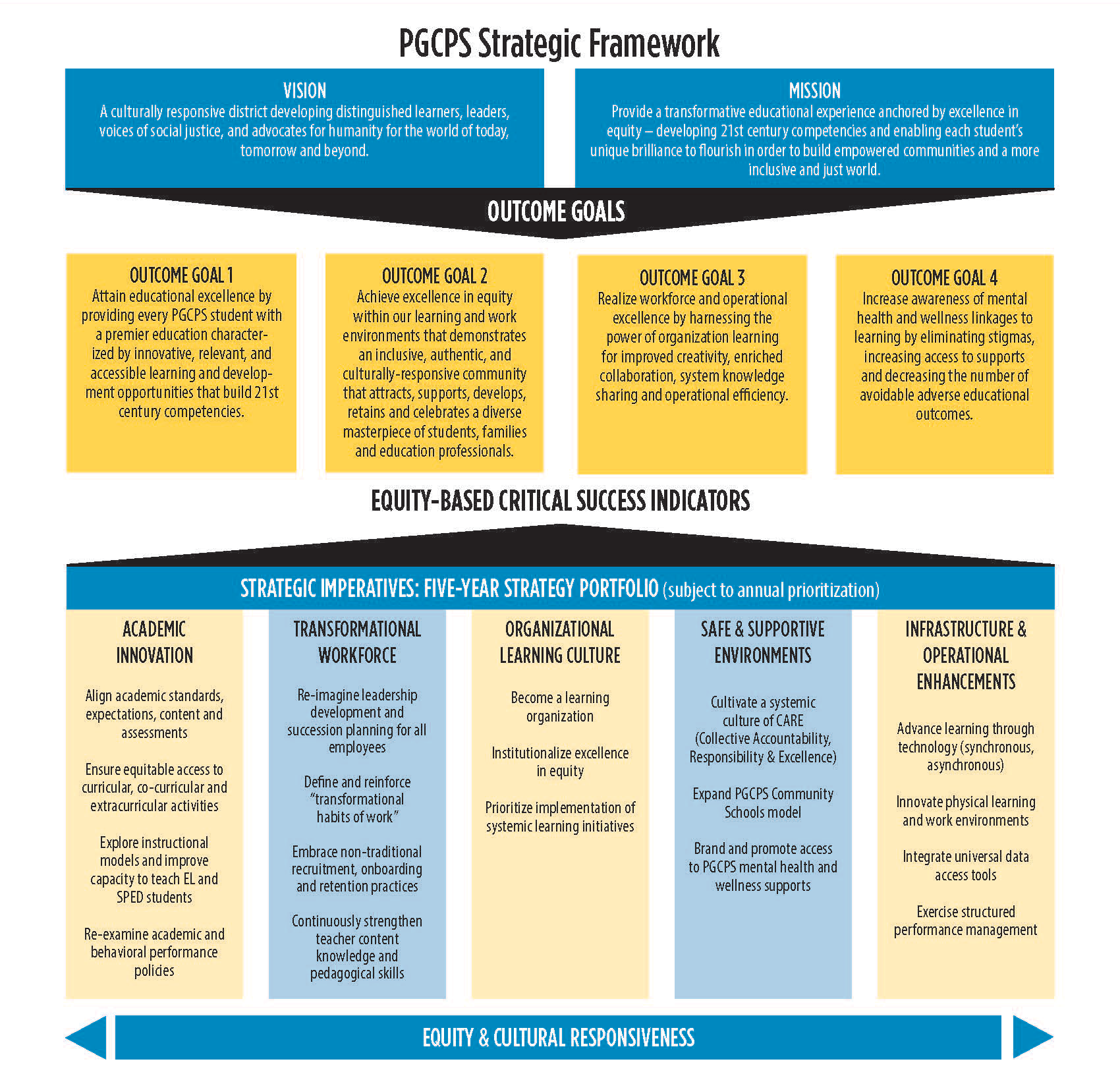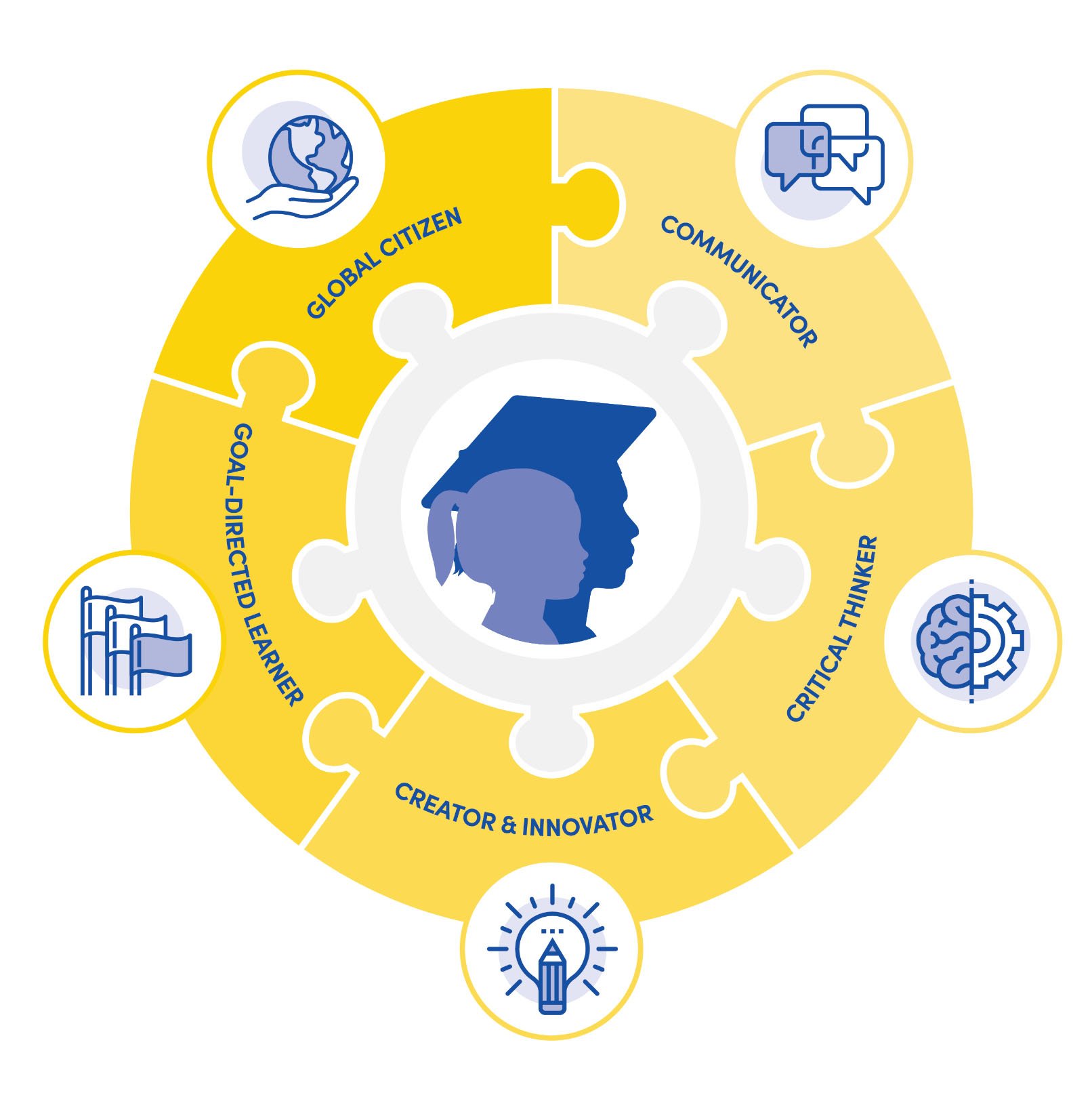Strategic Framework

PGCPS’ vision, mission and core values are the compass by which all actions are guided. They embody the ideals to which PGCPS is ultimately held accountable.
Vision
The vision is an image of a desired future reality. It presents the state of the environment when PGCPS has successfully fulfilled its mission. The vision is a direct reflection of PGCPS’ desire for its students, staff, schools, community and the broader society.
We are deliberately embarking on a journey of transformation where success is defined by ensuring every PGCPS student is able to achieve at or above standards and is inspired to realize their unique talents and individual pathways to success.
This vision paints a future of equity and justice where all stakeholders, regardless of background or experiences, have access to a broad array of relevant educational opportunities, high-quality learning environments and holistic support systems that empower them to succeed. It reflects a work environment where employees are fulfilled and empowered to innovate and all persons are respected and inspired to excellence in carrying out the mission.
Mission
Clarity of purpose is the first step toward transformation. Knowing what is to be achieved must first be preceded by an understanding of the reason we exist.
The mission or purpose statement defines the scope of our work and communicates to its internal and external stakeholders what it hopes to contribute to society by carrying out its mission. The mission answers the following questions:
- What do we do?
- For whom do we do it?
- How do we do it?
- What do we hope to achieve?
Maintaining a relentless focus and commitment to providing a distinctive educational experience grounded in equity and cultural responsiveness is at the heart of the PGCPS mission. This mission ensures access by all students to an expansive portfolio of relevant educational opportunities. Equally important is the commitment of PGCPS to foster physically and psychologically safe environments that support and empower the collective stakeholder community. We seek to inspire learning, develop strong academic skills, cultivate character, leadership, and social responsibility, and enable the discovery and sharpening of individuals’ unique gifts, skills, and abilities. PGCPS will harness the vast resources of the entire Prince George’s County community to partner in executing this mission and realizing the vision of more just and thriving global communities.
Outcome Goals
PGCPS has established four aspirational goals that describe the desired outcomes of transformation. These goals collectively serve as the “North Star” for PGCPS by which priorities will be set and progress will be monitored and reported.
Outcome Goal 1 – Attain educational excellence by providing every PGCPS student with a premier education characterized by innovative, relevant, and accessible learning and development opportunities that build 21st century competencies.
Outcome Goal 2 – Achieve excellence in equity within our learning and work environments that demonstrates an inclusive, authentic and culturally responsive community that attracts, supports, develops, retains and celebrates a diverse masterpiece of students, families and education professionals.
Outcome Goal 3 – Realize workforce and operational excellence by harnessing the power of organization learning for improved creativity, enriched collaboration, systemic knowledge sharing and operational efficiency.
Outcome Goal 4 – Increase awareness of mental health and wellness linkages to learning by eliminating stigmas, increasing access to supports and decreasing the number of avoidable adverse educational outcomes.
Theory of Action
Conceptually integrated into the Strategic Framework, PGCPS’ Theory of Action is multi-dimensional in nature and declares that we:
- Identify the unique knowledge, skills and supports needed for students to be college-, career-, and life-engaged and develop a rigorous, accessible, aligned, standards-based curriculum to meet these needs; then there will be clarity, consistency, coherency and equity in what educators will teach and what students will learn.
- Invest in continuous, relevant, professional development of educators, provide instructional strategies, supports, and growth-oriented feedback for implementation in the classroom; then instructional effectiveness will increase and student learning outcomes will improve.
- Embrace a culture of organizational learning and hold ourselves accountable through transparent and disciplined performance management that engages every level of the organization in a continuous cycle of data analysis, goal-setting, action planning, execution and monitoring; then we will build the capacity of district staff, school-based professionals and students to consistently strive for innovation, continuous learning and improvement.
- Develop a district culture that fosters cultural responsiveness and a sense of collective responsibility for student success amongst teachers, students, staff, families and communities; to deepen our understanding of students’ needs and create a shared purpose for our work leading to more effective practices and increased learning.
Strategic Imperatives
Throughout the planning process, stakeholder voice, research and empirical data trend analyses highlighted the strengths, priorities, challenges and opportunities that must be the priorities of PGCPS to achieve its vision of transformation. The data highlighted five strategic imperatives that will guide the work of PGCPS over the next five-year time horizon. Descriptions of these strategic imperatives and the strategies that have been prioritized within each for this planning period are presented as follows.
Academic Innovation
Foundational to our outcome goal of educational excellence is this strategic imperative. PGCPS must re-imagine teaching and learning in non-traditional ways to meet and inspire the needs of a dynamically changing community of learners – continuing to set high expectations and ensuring every student, in every grade, receives rigorous, engaging and relevant instruction that prepares students to be college-, career-, and life-engaged.
Essential to understanding this imperative is PGCPS’ Student Learner Profile. The Student Learner Profile gives definition and meaning to why academic innovation is vital to our mission. It describes the attributes and skills we want for all students to thrive in a dynamic, complex, global community. We believe these attributes are as important for our students as their learning of core academic content to ensure they are ready for their futures. Students in PGCPS are:
- Global Citizens
- Communicators
- Critical Thinkers
- Creative and Innovative Thinkers
- Goal-Directed Learners

Equally important for implementing this imperative is the Instructional Framework which translates our “why” into our “how.” Our Instructional Framework provides the blueprint for culturally responsive learning experiences throughout PGCPS that provide our students with opportunities to grow in the skills and attributes captured within the Learner Profile. It defines our expectations for instruction and provides a framework for consistently planning and implementing evidence-based practices in all grade levels, classrooms, and content areas. The Instructional Framework includes:
- Culture and Community;
- Curriculum Implementation;
- Learning Experiences; and
- Assessment and Reflection
Instructional Framework
With our Student Learner Profile and Instructional Framework at the center of our work, the following strategies are prioritized for this strategic imperative:
Align academic standards, expectations, content and assessments
Improve students’ overall performance on formal assessments through innovative content, targeted needs-based instruction and supportive programs aligned to learning standards, problem-solving skills and critical thinking competencies.
Explore instructional models and improve capacity to teach EL and SPED students
Confront the barriers to implementing strong co-teaching models with ESOL and non-ESOL certified instructors to maximize the transfer of high-yield and research-informed practices.
Ensure equitable access to curricular, co-curricular and extracurricular activities
Enable opportunity by expanding access to specialty programs and lottery-admission schools for underrepresented student groups. Develop co-curricular activities that encourage collaborative student, staff and community engagement, including lottery-admission schools.
Re-examine academic and behavioral performance policies
Review and refine academic and behavioral performance policies to enable equitable application, encourage improved student achievement and reinforce positive behavioral outcomes.
Transformational Workforce
PGCPS will attract, develop, support and retain a highly competent workforce of culturally responsive employees empowered to inspire and pursue excellence, promote creativity, stimulate critical thinking, and serve as agents of change for our students and for one another. The following strategies are prioritized to address this imperative:
Re-imagine leadership development and succession planning
establish relevant leadership development pathways and mentorship supports for ongoing professional development and upward mobility of all employees.
Define and reinforce “transformational habits of work”
Define standards for transformational work behaviors and “distributed leadership” (Hefeitz, 2009), provide developmental opportunities, career pathways and positive reinforcement for all employees.
Embrace non-traditional recruitment, onboarding and retention practices
Employ non-traditional methods, target untapped sources and design innovative approaches to attract, develop and retain high-quality employees representative of the cultural diversity of our PGCPS community.
Continuously strengthen teacher content knowledge and pedagogical skills
Continuously strengthen the quality of instructional practice through effective coaching, evaluation and professional development to support continuous learning and improvement of practice.
Organizational Learning Culture
Foster an environment of open collaboration, critical thinking and creation of alternative ideas. Embrace tolerance for the process of continuous learning, knowledge application, structured evaluation and routine reflection for continuous improvement.
Become a learning organization
Engage in active learning processes that enable individuals to become skilled at creating, acquiring and transferring knowledge that results in shared purpose. Cultivate tolerance, foster open discussion and equip employees to think holistically and systemically to adapt to the unpredictable with greater ease.
Institutionalize excellence in equity
Develop a mindset of equity in the daily operating norms of all organizational systems, processes, decisions, communications and interactions. Extend the concept of equity from conversations to actionable behaviors.
Prioritize implementation of systemic learning initiatives
Develop clear, integrated and disciplined processes and accountability for the launch, delivery, interpretation, adoption and evaluation of systemic learning initiatives.
Safe and Supportive Environments
Provide safe environments that foster a culture of care and a climate of mutual respect, cultural responsiveness, and attentiveness to the overall physical and psychological well-being of every PGCPS student, family member and employee. The following strategies are prioritized to address this imperative:
Cultivate a systemic culture of CARE (Collective Accountability, Responsibility and Excellence)
Maintain a welcoming, respectful and efficient environment in which all stakeholders understand, are accountable for and take pride in their contributions to PGCPS goals and objectives.
Expand PGCPS Community Schools model
Establish a regular dialog among school staff, students and families that creates a climate of shared understanding and addresses opportunities for and barriers to productivity, scholarship and advocacy.
Brand and promote access to PGCPS mental health and wellness supports
Organize and distinctly market PGCPS’ diverse and robust portfolio of mental health and wellness resources to enhance awareness, improve accessibility and mitigate skepticism of use.
Infrastructure and Operational Enhancements
Equitably provide students and staff the systems, facilities, technology, financial resources, organizational structures and support services that foster a positive learning and working environment. The following strategies are prioritized to address this imperative:
Advance learning through technology (synchronous, asynchronous)
Improve access to and use of relevant, evidence-based technologies (hardware and software) to enhance and support all learning environments for students and employees.
Innovate physical learning and work environments
Enhance, construct, upgrade and maintain physical learning and work environments that maximize safety, facilitate learning, invite collaboration and encourage productivity.
Integrate universal data access tools
Provide employees ease of access to quality data and integrated tools that allow informed and focused teaching, learning, problem-solving and decision-making.
Exercise structured performance management
Adopt a common approach in the use of data to inform and effectively guide prioritization, goal-setting, implementation, monitoring and evaluation of improvement strategies.
Assure equitable resource allocation
Align resources to strategic priorities and ensure distribution is equitable, efficient and effective for systems thinking, analysis, decision-making, prioritization and continuous improvement. By applying a performance management discipline toward transformative change, the school district is on course to realize its vision.
